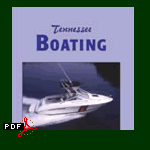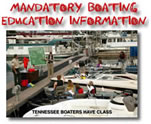
Online Licensing
|
SAFETY TIPS
Water Skiing
To make your water skiing fun, safe, sensible and successful, practice these safe driving tips:
- Check steering and throttle controls for proper operation before towing skier.
- On take-offs, never accelerate until a definite signal is given by skier.
- When under way, keep attention ahead. The observer is to watch the skier.
-
Never follow other boats. Always look before turning. Avoid shallow water.
- Promote safety by staying away from other boats, swimmers, fishermen and solid objects.
- Return to fallen skier immediately. Slow to idle as you approach skier, moving in on the driver's side.
- Shut off engine while skier climbs into or out of boat. Discourage skiers from boarding over transom.
- High speed landings cause injuries. When skiing into shore, reduce speed and parallel the landing area at a safe distance.
- Do not tow non-swimmers or weak swimmers unless they wear an approved and appropriate flotation device.
Person Overboard
If someone falls overboard, follow these procedures:
- Toss a life-saving device even if the person can swim. A life ring is the preferred device. It can be thrown farther and is easier to hang on to. However, use whatever device is nearest. Time is essential.
- Slow the boat, keeping the person in view. Other persons onboard should act as look outs. At night, direct the best possible lights on the victim.
-
Try to approach the person from downwind or into the waves. Always use common sense and good judgment. Consider existing condition and ability of the victim and what other help is available. If someone aboard is capable, have the person put on a life-saving device with a line attached to the boat and enter the water to assist the person.
- Always stop the motor when someone is going over the side, or coming aboard.
- Assist the person in boarding the boat. It is difficult to climb into a boat from the water. The person may be hurt or cold and may require help.
Passengers
- Wearing a PFD is your only guarantee against drowning.
-
Do not overload the boat.
- Avoid horseplay.
- Have Personal Flotation Devices (PFDs) readily available for everyone.
- In small boats, remain seated.
- Trim boat by placing passengers and gear in balance.
Before Leaving
- Tell someone where you are going and when you expect to return.
-
Check weather forecasts.
- Ventilate bilges before starting engine.
-
Be sure your boat is basically equipped.
While Underway
- Know and obey the rules of the road.
-
Post a lookout for bathers, fishermen, swimmers, debris.
- Reduce speed in harbors and in confined areas.
Avoid excessive speed.
- Make no sharp turns at high speed.
- Watch your wake! You could be responsible for injury or damage caused by it.
- In rough water, stay low in the boat and cross waves at a slight angle.
- Keep red-buoys on your right when traveling upstream.
- Tying up to buoys or anchoring in channels is forbidden.
-
Carry sufficient tools for minor repairs.
Fueling
- Stop smoking and extinguish all fires.
-
Close all vents, doors, hatches.
- Ground the nozzle to tank opening.
-
Portable tanks should be filled outside of boat.
- Ventilate engine compartment before starting.
Power Line Dangers
When sailing, especially in unfamiliar waters, keep a close watch for low-hanging power lines. A great danger of electrocution exists if the mast of your vessel contacts the power line or gets close enough for the electricity to arc to your mast.
Weather
Observe cloud formation for pending weather changes.
Play safe and head for shore if the wind increases.
Boater Education
To make your time on the water more enjoyable and safe, really get to know your sport. Boating education can be as simple as a self-study course at home to organized formal classes which range from basic boating to advanced seamanship. Most classes are free, or charge only a small fee for books and materials. Shown below are some contacts to help you on your way to becoming a more knowledgeable boater.
|



|

